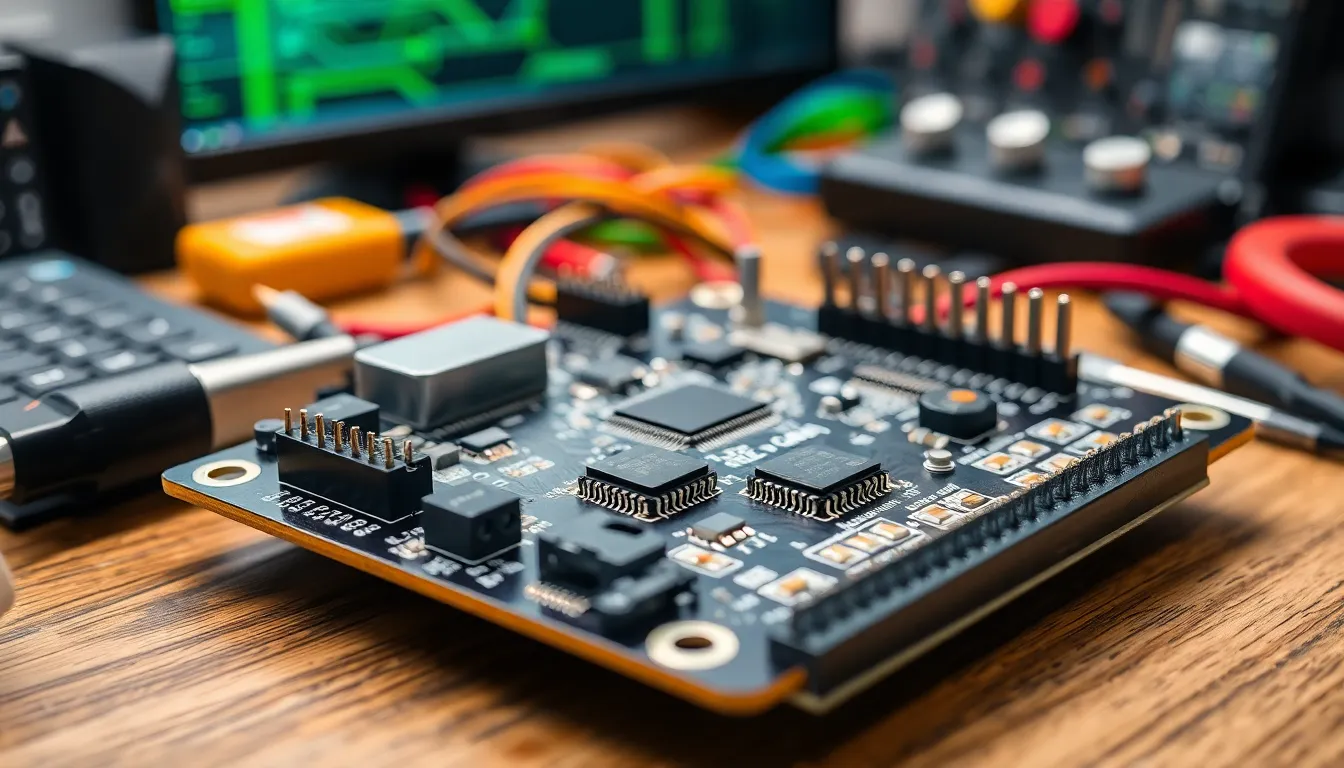Microcontrollers are the unsung heroes of modern technology, powering everything from household appliances to advanced robotics. These tiny computers pack a punch, enabling devices to perform specific tasks efficiently and effectively. Understanding how to program microcontrollers opens the door to endless possibilities for innovation and creativity.
As technology continues to evolve, the demand for skilled individuals who can harness the capabilities of microcontrollers is on the rise. Whether it’s for hobby projects or professional applications, mastering microcontroller programming can set one apart in a competitive landscape. This article delves into the essentials of programming microcontrollers, providing insights that can help anyone from beginners to seasoned developers unlock their full potential.
Table of Contents
ToggleOverview of Microcontrollers
Microcontrollers serve as compact computing devices that integrate a processor, memory, and input/output (I/O) peripherals on a single chip. These embedded systems manage specific tasks in various applications, providing control and automation. Widely used in electronics, they power devices such as home appliances, automotive systems, medical equipment, and industrial machines.
Microcontrollers come in diverse architectures, including 8-bit, 16-bit, and 32-bit options. Popular models, such as the Intel 8051, Microchip PIC, and ARM Cortex, offer different capabilities that suit distinct application requirements. Most microcontrollers feature built-in features like timers, analog-to-digital converters (ADCs), and pulse-width modulation (PWM), enhancing their versatility.
Programming microcontrollers involves using languages like C, C++, or assembly, enabling developers to write efficient code. Development environments, such as Arduino IDE, MPLAB, or Keil, simplify the coding process with user-friendly interfaces and libraries. Understanding hardware specifications and programming environments remains crucial for effective microcontroller application.
Microcontrollers interact with a variety of sensors and actuators, creating responsive and intelligent systems. Common applications include robotics, where they process input from sensors to control motors, and smart home devices, which respond to user commands or environmental changes.
The growing demand for microcontroller-based projects highlights the need for skilled programmers. Engaging with this technology opens paths to innovative solutions and smart applications, driving progress in various fields.
Key Components of Microcontrollers

Microcontrollers consist of several key components that define their functionality and performance. Understanding these components provides insights into programming and utilizing microcontrollers effectively.
CPU Architecture
CPU architecture determines how microcontrollers process data and execute instructions. Common architectures include:
- 8-Bit: Suitable for simple tasks and low-power applications. Examples include Microchip PIC16 series.
- 16-Bit: Offers improved performance for moderate complexity tasks. Examples include Texas Instruments MSP430.
- 32-Bit: Delivers high performance for advanced applications, supporting larger data types and enhanced processing capabilities. Examples include ARM Cortex-M series.
Different architectures enable specific applications across various industries, such as consumer electronics and automotive systems.
Memory Types
Microcontrollers employ various memory types, crucial for storing instructions and data. The main memory types include:
- ROM (Read-Only Memory): Non-volatile memory used for firmware and bootloader storage.
- RAM (Random Access Memory): Volatile memory for temporary data storage during operation, enabling fast read/write operations.
- EEPROM (Electrically Erasable Programmable Read-Only Memory): Non-volatile memory for retaining critical information even when power is off, often used for configuration settings.
Each memory type impacts the microcontroller’s performance and programming flexibility.
I/O Ports
I/O ports facilitate communication between the microcontroller and external devices. Key types of I/O ports include:
- Digital I/O: Allows for binary data input and output, enabling simple on/off control of devices such as LEDs or switches.
- Analog I/O: Enables interaction with analog signals, useful for sensors measuring temperature, light, or sound.
- Serial Communication Ports: Include UART, SPI, and I2C, allowing for complex data exchange with peripherals like displays and other microcontrollers.
Effective management of I/O ports enhances the versatility and capability of microcontroller projects.
Programming Microcontrollers
Programming microcontrollers involves using specific languages and tools that facilitate the creation of efficient embedded systems. With various programming languages and development environments available, programmers can choose the best fit for their project requirements.
Programming Languages
Numerous programming languages cater to microcontroller development. Common options include:
- C: Known for its efficiency and control, C is often the primary choice for programming microcontrollers due to its low-level access.
- C++: This object-oriented language builds on C, providing additional features for complex applications while maintaining performance.
- Assembly Language: Offers granular control over hardware, making it suitable for applications requiring the utmost efficiency.
- Python: Increasingly popular in the maker community, MicroPython allows for easier integration and quicker prototyping.
- Java: Rarely used for low-level programming, Java finds application in high-level microcontroller environments like Arduino.
Development Environments
Development environments streamline the programming process for microcontrollers. Notable environments include:
- Arduino IDE: This user-friendly platform simplifies coding and uploading to Arduino-based microcontrollers, making it suitable for beginners.
- MPLAB X IDE: Specifically designed for Microchip devices, MPLAB X provides advanced features for professional development.
- Keil uVision: This robust environment supports ARM architecture, offering extensive debugging features and middleware options.
- PlatformIO: An open-source ecosystem that accommodates multiple platforms, simplifying development across various microcontrollers.
Debugging Techniques
- Simulation: Testing code in a simulated environment helps identify errors before deploying to actual hardware.
- In-circuit Debuggers (ICDs): These tools allow for real-time debugging by interfacing directly with the microcontroller, enabling step-by-step execution.
- Serial Monitoring: Outputting data to a serial console helps track the program’s flow and identify issues based on operational feedback.
- Code Reviews: Collaborating with peers through code reviews can highlight potential errors or inefficiencies in programming logic.
Applications of Microcontrollers
Microcontrollers play a crucial role across various fields, driving innovation and enhancing efficiency. Their versatility allows integration into a myriad of applications, making them indispensable in today’s technological landscape.
Consumer Electronics
Microcontrollers enable functionality in consumer electronics such as televisions, washing machines, and digital cameras. They process user inputs, control display interfaces, and manage device operations. For instance, TVs use microcontrollers to switch channels, adjust volume, and handle remote control signals. Washing machines rely on them to regulate water levels, timing, and cycle selection. Digital cameras employ microcontrollers to control image processing, autofocus systems, and shutter mechanisms.
Industrial Automation
Microcontrollers transform industrial automation by controlling machinery and processes efficiently. They manage robotic arms, conveyor systems, and temperature sensors within manufacturing plants. For example, microcontrollers execute precise movements in robotic systems and monitor production lines for quality control. Additionally, they facilitate communication between machines and central control systems, enhancing operational efficiency and reducing downtime.
IoT Devices
Microcontrollers are foundational in Internet of Things (IoT) devices, enabling smart functionality and connectivity. Devices such as smart thermostats, wearable fitness trackers, and smart home security systems utilize microcontrollers for data processing and communication. Smart thermostats adjust heating and cooling based on user preferences, while fitness trackers monitor health metrics and sync data to mobile applications. Security systems leverage microcontrollers to process video feeds and send real-time alerts, ensuring comprehensive monitoring and safety.
Future Trends in Microcontroller Technology
Microcontroller technology is evolving rapidly, with several key trends shaping its future.
Increased Integration
Increased integration of microcontrollers and system-on-chip (SoC) designs enhances performance. These SoCs combine multiple functionalities onto a single chip, improving efficiency and reducing power consumption.
Advanced Connectivity
Advanced connectivity features gain prominence as devices require seamless communication. Integration of wireless technologies like Bluetooth, Wi-Fi, and LoRa into microcontrollers fosters the development of interconnected devices, fundamental to the Internet of Things (IoT).
Enhanced Processing Power
Enhanced processing power characterizes new microcontroller models, featuring higher clock speeds and improved architectures. This increase supports complex applications, including artificial intelligence (AI) and machine learning (ML), directly on microcontrollers.
Energy Efficiency
Energy efficiency remains a critical focus. Low-power microcontrollers enable battery-operated devices to operate longer and reduce carbon footprints. Manufacturers continue to innovate power management techniques to optimize energy usage.
Security Features
Security features are paramount in microcontroller design. Support for hardware-based security measures, such as secure boot and encryption, becomes standard to protect against cyber threats. This trend is essential as more devices connect to networks.
Development Tools and Ecosystems
User-friendly development tools and ecosystems expand rapidly. Platforms like Arduino, Raspberry Pi, and others offer accessible programming environments, attracting new developers. This accessibility encourages experimentation and innovation.
Real-time Processing
Real-time processing capabilities become essential as applications demand instant responses. New architectures support real-time operating systems (RTOS), allowing microcontrollers to handle multiple tasks concurrently with minimal latency.
Growing Industries
Growing industries drive microcontroller demand. Sectors like automotive, healthcare, and smart home technology increasingly rely on microcontrollers for automation, monitoring, and improved user experiences. This trend predicts a rise in custom solutions tailored to specific applications.
Sustainability Initiatives
Sustainability initiatives influence microcontroller manufacturing. Companies prioritize eco-friendly materials and practices, responding to increasing environmental concerns. Development of green microcontrollers aligns with global sustainability goals.
Embracing these trends positions microcontrollers at the forefront of technology, facilitating advancements across various applications.
Mastering microcontroller programming opens up a world of possibilities in technology. As devices become smarter and more interconnected, the demand for skilled programmers continues to rise. By understanding the intricacies of microcontrollers and their applications, individuals can contribute to innovative solutions across various industries.
The evolving landscape of microcontroller technology, with its focus on efficiency, connectivity, and security, presents exciting opportunities for both new and experienced developers. Embracing these advancements not only enhances programming skills but also positions individuals to be at the forefront of technological progress. Whether it’s in IoT, robotics, or consumer electronics, the journey into microcontroller programming is sure to be rewarding and impactful.



